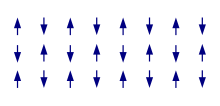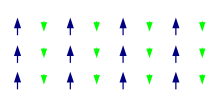Magnetic order



With the magnetic order one means the characteristic of a preferred alignment of the atomic magnetic moments to each other.
The creation of a preferred alignment lies in the exchange interaction of the total atomic torques . A certain arrangement is energetically more advantageous and thus leads to a coupling. This can be clearly understood using a simple model, if one imagines a solid body made up of small bar magnets : If you place two such magnets next to each other, they will align themselves antiparallel. However, if you have a lot of magnets in a three-dimensional arrangement, the energetically more favorable option can also be a different orientation.
There are different classes of magnetic order:
- Ferromagnetic order
- Here, the magnetic moments are preferably parallel to one another. The elements iron , nickel and cobalt are ferromagnetic substances.
- Antiferromagnetic order
- In this case, the preferred orientation is anti-parallel. The simple oxides of the ferromagnetic elements are antiferromagnetic.
- Ferrimagnetic order
- Ferrimagnets are a hybrid between ferro and antiferromagnets. Here the alignment of the magnetic moments is anti-parallel, but they are stronger in one orientation. Ferrites and iron grenades fall into this category.
- Non-collinear moments
- There are also a few materials in which the magnetic moments point neither parallel nor anti-parallel, but in different spatial directions. These substances behave similarly to antiferromagnets.
There are different manifestations in all classes. Elementary wave-like excitations of the magnetic order are called magnons . The energy required to excite such a magnon is far below the energy that would be required to flip a spin against its preferred direction.
The magnetic order is destroyed above a critical temperature. For ferromagnets this is called the Curie temperature , for antiferromagnets the Néel temperature . Above their respective limit, the substances behave paramagnetically . There are differences between the different classes in all phenomena related to the magnetic order. The magnetic susceptibility below their respective threshold temperature and the dispersion relation for magnons are fundamentally different.